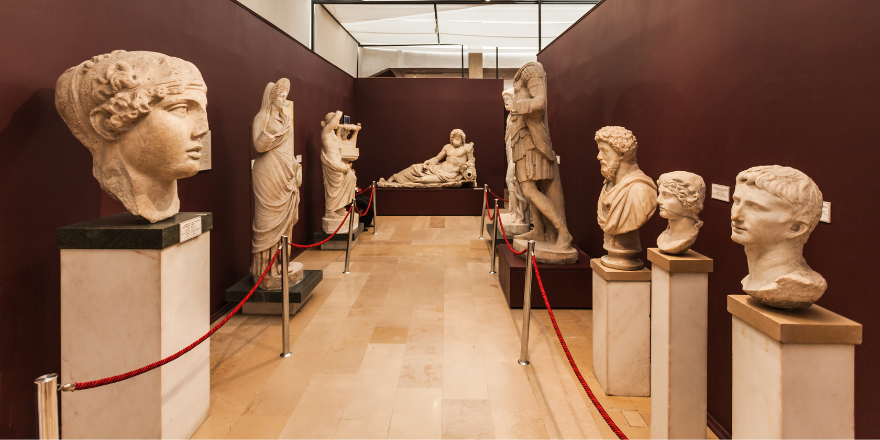15 One-of-A-Kind Artifacts and Where to See Them
Travel

Audio By Carbonatix
The world is full of rare and fascinating treasures—objects that have withstood the test of time and tell the story of humanity’s past, art, and ingenuity. From ancient relics to modern marvels, here are 15 one-of-a-kind artifacts and where you can see them in person!
1. The Rosetta Stone – British Museum, London, UK
This famous slab of granodiorite unlocked the secrets of Egyptian hieroglyphs, thanks to its trilingual inscription in Greek, Demotic, and hieroglyphics. It’s the ultimate key to understanding ancient Egyptian civilization.
2. The Dead Sea Scrolls – Israel Museum, Jerusalem, Israel
Dating back over 2,000 years, these ancient Jewish texts include some of the oldest biblical manuscripts ever discovered. They were found in caves near the Dead Sea in the 1940s and have reshaped our understanding of religious history.
3. The Terracotta Army – Emperor Qinshihuang’s Mausoleum Site Museum, Xi’an, China
An army of over 8,000 life-sized soldiers, horses, and chariots guard the tomb of China’s first emperor, Qin Shi Huang. Each warrior has unique facial features, making this one of the most remarkable archaeological discoveries of all time.
4. The Shroud of Turin – Turin Cathedral, Italy
This controversial and mysterious linen cloth bears the image of a man many believe to be Jesus Christ. Whether a religious relic or an incredible medieval artifact, it remains a source of debate and fascination.
5. The Antikythera Mechanism – National Archaeological Museum, Athens, Greece
An ancient Greek analog computer dating back over 2,000 years, this intricate device was used to predict astronomical positions. It’s often called the world’s first known mechanical computer.
6. The Hope Diamond – Smithsonian National Museum of Natural History, Washington, D.C., USA
Weighing an astonishing 45.52 carats, this deep blue diamond is famous for its beauty—and its supposed curse. Legends claim misfortune befalls those who own or wear it, adding to its mystique.
7. The Venus de Milo – Louvre Museum, Paris, France
This breathtaking Greek sculpture, dating back to around 150 BCE, is renowned for its missing arms and enigmatic beauty. It’s considered one of the greatest masterpieces of ancient Greek art.
8. The Spear of Destiny – Hofburg Palace, Vienna, Austria
Said to be the lance that pierced the side of Jesus Christ during the crucifixion, this relic has been linked to mystical powers and historical figures, including Charlemagne and Adolf Hitler.
9. The Crown Jewels of England – Tower of London, UK
A dazzling collection of crowns, scepters, and orbs, the British Crown Jewels include the legendary Koh-i-Noor diamond and the Imperial State Crown, used in royal coronations.
10. The Mask of Agamemnon – National Archaeological Museum, Athens, Greece
This golden funeral mask, discovered at Mycenae, was once believed to belong to the mythical Greek king Agamemnon. Though its true origins remain debated, it’s one of the most famous artifacts of ancient Greece.
11. The Moai Statues – Easter Island, Chile
Scattered across the remote Easter Island, these colossal stone heads were carved by the Rapa Nui people. Their exact purpose and how they were moved remain one of archaeology’s great mysteries.
12. The Liberty Bell – Philadelphia, Pennsylvania, USA
An enduring symbol of American independence, the Liberty Bell is famous for its crack and the message of freedom it represents. Visitors can see it up close at the Liberty Bell Center.
13. The Book of Kells – Trinity College Library, Dublin, Ireland
This illuminated manuscript, created by Celtic monks around 800 CE, is a masterpiece of medieval art. Its intricate illustrations and calligraphy make it one of the most beautiful books ever made.
14. The Sarajevo Haggadah – National Museum of Bosnia and Herzegovina, Sarajevo
This 14th-century Jewish manuscript survived wars, pogroms, and even the Nazis, thanks to the bravery of those who protected it. It’s an incredible symbol of cultural resilience.
15. The Turin Papyrus Map – Egyptian Museum, Turin, Italy
The oldest known topographical map, this 3,000-year-old papyrus scroll provides a detailed plan of an ancient Egyptian gold mine. It proves that ancient engineers were remarkably advanced in cartography.
Embark on a Treasure Hunt!
From shimmering jewels to ancient manuscripts, these artifacts are scattered across the globe, waiting for curious travelers to see them firsthand. Which one will you visit first? Let me know, and I’ll help you plan your adventure! 🌍✨

